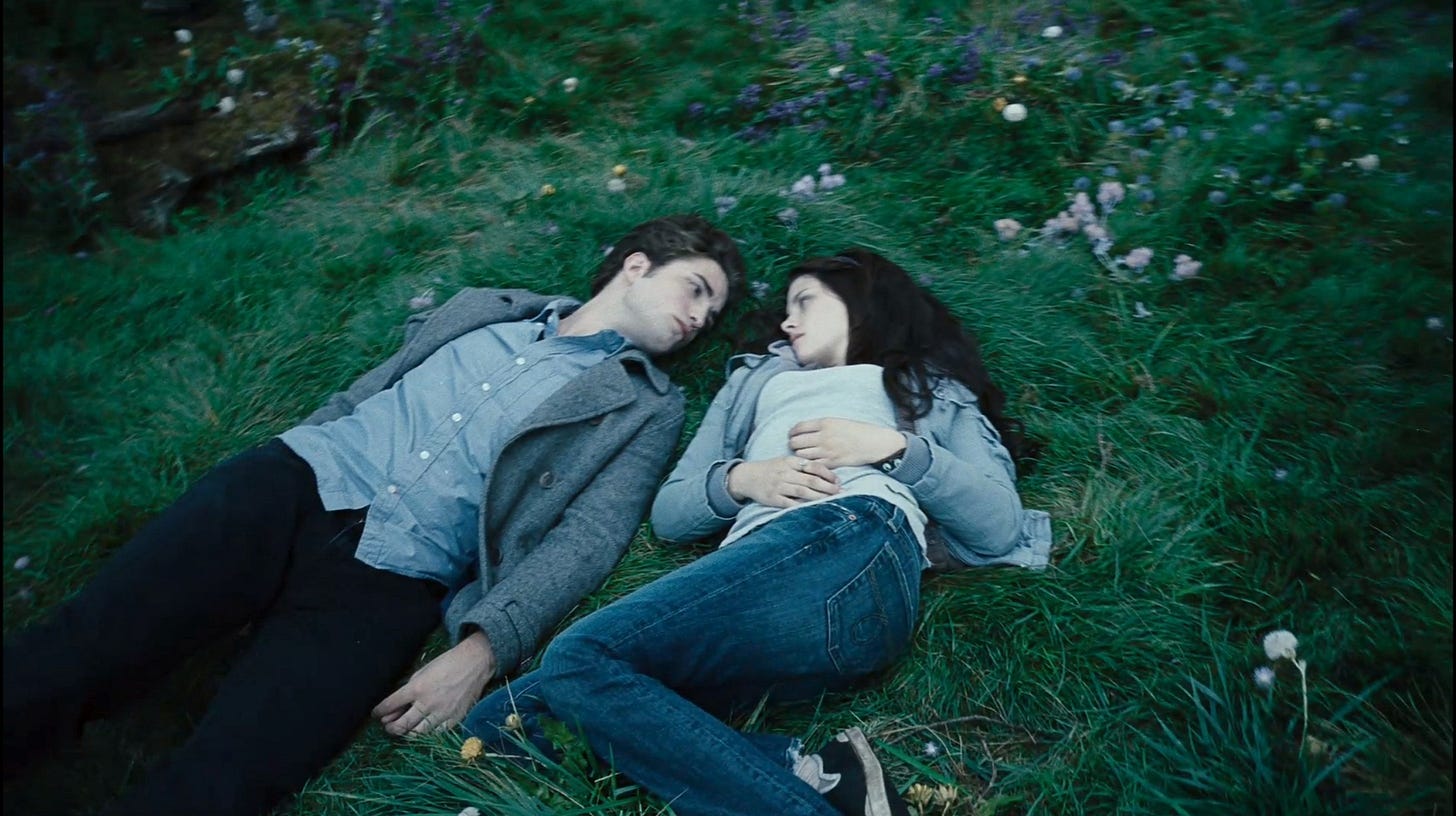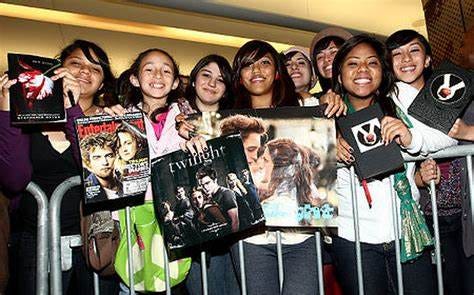Villainy to Virtue: How the Vampire Became our Mormon Boyfriend
essay on vampirism in media, February 2023
In mid 2002, Nickleodeon would release one of the most notable episodes of their classic children’s series SpongeBob, titled “Graveyard Shift”. Nearly twelve minutes into the episode, viewers were presented with a frame that felt uncharacteristically ‘off’ from the trademark style and animation. While the episode focuses on tame and child-friendly horror, nearly 4 million U.S. viewers found themselves confronted with an unnerving and lifeless image of Nosferatu—the infamous 1920’s character vampire—that was deemed as too scary for children’s media. Fans of the animated series still recount the horror from the three second frame, with Reddit users like _Zaayk_ citing that the scene “still scares [them]”, going as far as having to “walk out of the room” when reruns of the episode play. The frightened reactions to “Graveyard Shift” demonstrated that even energetic and satirical media like SpongeBob could not take the ghastly bite out of the vampire.
The vampire, characterized as an un-dead blood sucker, originated in literary renditions of historical myths. Now turned into an icon of Gothic literature and media—the vampire’s long-standing status of villainy has since shifted. Three years after Nickelodeon debuted “Graveyard Shift”, Mormon author Stephanie Meyer would release her best-selling young adult novel Twilight, kicking off her world-wide success as a book-to-movie franchise titan. Meyer’s work would achieve what writers at Nickelodeon failed to do—as Twilight and its sequels New Moon, Eclipse, and Breaking Dawn would redefine the vampire’s presence in Gothic literature—ultimately transforming the infamous fanged demons into dreamy boyfriends with sparkly abs. However, when analyzing Meyer’s twist on the dated vampire, it’s clear that her religious background cannot be separated from her work. Seemingly, the only old blood-sucking trope that Meyer couldn’t excuse was the vampire's predictable sense of gentleman-like masculinity and bourgeois sense of wealth and domination. Still, there are still some surprises in Twilight’s romantic narrative that additionally hint to the influence of Mormon faith—like the near complete absence of sex and all that is risqué (until the vampire, Edward Cullen, and narrator, Bella Swan, get married, of course).
On and off the page, vampires never really die. Thanks to authors like Stephanie Meyer, the vampire seems as if it will continue to change and bend to suit current audiences—so why did it take so long for series like Twilight to happen? The success of the franchise can arguably be credited towards Twilight’s non-vampire narrator, fictional teenager Bella Swan—a female protagonist that would reignite the vampire genre and female-driven romances. Rather than trying to get readers to identify with the vampire (Lindqvist’s Let the Right One In—which was released a year prior), Meyer probably understood that it was too soon for consumers to sympathize with blood sucking demons—but not to desire sex with them. Thus, the narrator Bella Swan enters-a character so plain that anyone can identify with her.
Writer and editor Karen Backstein seems to agree with this notion in her 2009 article featured in Cineaste, “(Un)safe Sex: Romancing the Vampire”. Here, Backstein acknowledges that young female fans of Twilight “strive for audience identification with the heroine—with her strength, her extraordinary capabilities, her status as an object of desire, or a combination of all these traits”. However, Twilight wasn’t only influencing swooning young girls. Subsequently, more mature and grim vampire media came along (True Blood, Buffy the Vampire Slayer, Penny Dreadful) and proved that Hollywood “crossed over to capture a huge audience of older women, who lapped up their Gothic atmosphere, dreamy heroes, and romantic focus.” (Backstein). In other words, it wasn’t just the actual vampire that set off the trend of vampirism in early 2000’s media—but the female protagonist and how she represented women of all ages. In a Bella Swan centered universe, Twilight is about how women (represented through Bella) challenge manifestations of loneliness, isolation, and desire (personified as vampires).
However, it would be arbitrary to not acknowledge the equally driving force that resulted in the poignant spin on vampires—the vampire himself. Twilight chronicles our narrator's love story and eventual marriage to vampire Edward Cullen—before she turns into a vampire herself. Having just moved to the blueish-green town of Forks, Washington (one of the real-life rainiest places in the world), author Stephanie Meyer makes it clear that Bella Swan is miserable in her new setting since she is instantly popular despite thinking that she is deeply unlikable. To her resentment—clearly out of insecurity, all eyes are on her. Rather than trying to bond with other female friends, Bella takes an interest in her angsty classmate (and closeted vampire) Edward Cullen. Soon, Bella learns of Edwards secret and is embraced by his equally attractive vampire family before becoming one herself in the last novel, Breaking Dawn.
The enigma that is Edward Cullen would capture an entire generation of young women thanks to the combination of his dreamy, brooding, and sometimes aggressive traits (not to mention good looks of his screen adaptation, played by Robert Pattinson, who was dubbed “the most handsome man in the world” by The Daily Mail). Apart from his chiseled cheekbones and glowing abs, Cullen’s sex appeal lies within the depth and duality of his character—forever trying to nurture a balance between monster and man. This profound existential dilemma exists within all vampire cliches, making them the perfect vessel for a romantic interest. Writer Ananya Mukherjea’s article “My Vampire Boyfriend: Postfeminism, ‘Perfect’ Masculinity, and the Contemporary Appeal of Paranormal Romance” acknowledges this phenomenon. “My Vampire Boyfriend” notes the modern vampire's usage of their “superhuman strength” in both the quarrels that come with being a blood-sucking demon and the restraint necessary to be a caring protector. This duality is what made characters like Edward—and the vampire genre overall—so attractive to consumers all over the world. Twilight threw out the overdone shallow jock love interest and replaced it with a sensitive and emotionally intelligent partner that put his girlfriend’s needs over his own—and it was this quality of being cared for that captured the hearts of teenage girls everywhere.
While the cult-like success of Twilight seemed to be revolutionary at the time, the popularity of Gothic literature with female audiences isn’t new. Whether or not these stories attract women due to their domestic attitude or the prowess of the typical romantic heroine seems to be an ongoing debate within the literary community. Janice Radway, an American literary scholar, investigates why seemingly dated tropes of masculinity and borderline offensive female protagonists have struck such an undeniable chord with women. In her 1981 article, “The Utopian Impulse in Popular Literature: Gothic Romances and ‘Feminist’ Protest” Radway explains that since romance novels rarely ever portray “women’s possibilities in bourgeois society” it is perplexing to question whether these narratives rely on “the cult of domesticity […] or covert feminist protests at the subjugation of women”. Seemingly, the narrative will always conclude with the heroine finding happiness in the arms of her dominating partner—but also allowing the reader to identify with the heroine who is either resistant to men due to an abusive past or finds solace in her own independence. Whether or not gothic romance novels can be considered radically feminist or inherently misogynistic lies within the narrative itself on a case-by-case basis.
When looking to stories like Twilight to find this answer, Meyer’s use of Mormon themes proves it to be the latter. Apologies to all the ‘Team Edward’ fanatics, but Cullen’s sensitive charm does not preclude his uncomfortably conservative creation at the hands of Stephanie Meyer. While the narrative revolves around the love story between Bella and Edward, there is a strong sense of family dynamic and value within the story. Meyer paints teenage Bella Swan to be disconnected from her divorced parents and aimlessly searching for connection despite her awkward and clumsy social skills. Upon becoming a part of Edward’s life, Bella’s confidence soars and it’s notable that her exaggerated sense of clumsiness fades away as the narrative progresses—almost as if Meyer forgot that Bella slips, trips, and falls at least five times in the first book. The Cullen vampire family (comprised of loving husband and wife duo in addition to their five adoptive adult children) are presented as Bella’s saving grace—regardless of the deep love and care Bella’s actual father, Charlie, showers her in. Meyer’s subtle praise of the nuclear family and degradation of divorcees is representative through vampire's lack of mortality—the Cullen’s can love Bella forever, long after her real family has died.
Further, Edward’s obsessive nurturing and protection of Bella is, at times, more fatherly than romantic. When living with her father, Charlie Swan, Bella notes that he never really grew beyond his past marriage—unable to find happiness in himself. As a result of this, Bella often takes on daily chores that liken her to a housewife rather than a daughter. Writer Anna Silver weighs in on the impact of Bella’s lack of father figure in her article “’Twilight’ is Not Good for Maidens: Gender, Sexuality, and The Family in Stephanie Meyer’s ‘Twilight’ Series”. Looking at Bella’s family dynamic, Silver concludes that Bella’s attraction to Edward is unsurprising and seemingly manifested through her longing for a father—an outdated and offensive stereotype for women with infamously dubbed ‘daddy issues’. Meyer portrays Bella to be, at her core, seeking a caretaker rather than a boyfriend—a theme in line with Mormonism’s 1950’s-esq gender ideology. This claim is easily justifiable when remembering that Edward isn’t really a high schooler, but in fact an undead 104-year-old in a sixteen-year-olds body. While this theme would resonate as subtle pedophilia or incest to adult readers, the issue lies within Twilight’s intended and impressionable audience—young women. As Meyer pushes the idea that a caretaker is more attractive than an equal relationship—young readers are expected to feel the same since they’ve already forcibly identified with Bella, ultimately making an unintended connection to age and attraction.
Ultimately, it’s discomforts like these that would damage Meyer’s (and subsequently Twilight’s) reputation over the years. Other issues including vampire sister Rosalie’s obsessive pro-life stance, Bella’s foregoing of college to have a vampire baby that could kill her, and the various interpretations of Bella dying (turning into a vampire) at the hands of Edward in Breaking Dawn Part 1 bring up other relevant conversation regarding the awkward gender depictions within the series. Now over twenty years since Twilight’s original release, vampire fanatics have seen Twilight copycatted into oblivion thanks to its cult-following and monumental success. As the 2010’s progressed, these tiring themes of brooding purity were eventually mocked repeatedly (South Park and Saturday Night Live) until the romantic vampire reign would come to an end. However, because of Meyer, the vampire's image has been softened into a character worthy of love and affection—ultimately leading (as predicted) into a period of vampire identification and relatability—just in time to revisit the new adaptations of movies like Let the Right One in and Bones and All. Still, the post-Twilight mocking of vampires hasn’t entirely ceased, and vampire comedies fill the other side of the spectrum (2023’s Renfield). While it’s clear that the vampire genre has progressed since Twilight, it’s difficult to find any original vampire work in the 2020’s. Whether or not Meyer’s series focused on the dangerous and dated themes or conservativism and Mormonism, it’s hard to ignore that her work struck a chord with world-wide audiences like never before. Perhaps this is due to the unique originality of Twilight or because it seemed to unlock some sort of primal lust for gender roles that are now unneeded. Either way, Twilight’s success undeniably pumped blood back into the dated vampire and will continue to influence the way vampire media is not only made but additionally received.








